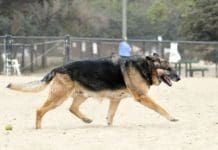Home Search
dog park - search results
If you're not happy with the results, please do another search
Parvo Victim # 2
The name Ray Carlisle is synonymous with Doberman Pinschers. A breeder and exhibitor for 40 years, a show judge for the last 20 years, and a former president of the Doberman Pinscher Club of America, the United Doberman Club, and the American Working Dog Federation, the New York resident travels the world on behalf of his favorite breed. I vaccinated my dogs for many years
It’s All in Your Dog’s Eyes
Teaching our dogs to look at us is important for training; if we have their attention, we can get them to work with us. If we can keep their attention, we can keep them working with us even in the face of distractions. These things are big accomplishments, but the value of teaching eye contact is even bigger!
What Love Means to Your Dog
When it comes to love, dogs offer all of the devotion with none of the guile. They won't sign up for a secret account on Match.com, or see another owner behind your back. And that flirtation with the pet sitter
well, it's harmless. After all, there's a reason dogs have a reputation for being faithful friends. Reciprocating, though, can sometimes be a challenge. Dogs, you remember, approached our hearth; it has been in many ways a rather lopsided arrangement in the love department since the dawn of time. And with our busy lives and competing priorities, we humans have altogether too few opportunities to return that cupidity in kind although, given how utterly and completely most of our dogs rely on us, that's a tall order under even the best of circumstances.
Fluency and Generalization in Dog Training
Fluency and generalization training methods prepare your dog to respond and behave correctly in ANY situation. In dog training, generalization means that your dog can apply a concept to many situations; he knows that Sit!" means he should sit whether he's home
Preparing Your Dog for a Successful Surgery
The word surgery
Regarding Those Online Prescription Letters for Emotional Support Animals
A hot button" topic within the service-dog community is the availability of online prescription letters for emotional-support animals. It's important to remember that an emotional-support animal is required to mitigate a disability. The legal definition of disability is when one or more of a person's activities of daily life is severely impacted. If you are truly experiencing the impairment of a major life function
Unsticking Myths About Dogs
apprehensive
10 Ways to Make Your Old Dog Comfortable
Sometimes we don't want to admit our dog is aging. We ignore the graying muzzle and scoff at the idea of a senior dog food." After all
How to Create Just a Little More Physical Space Between You and Your Dog...
you can direct her out of your way by having her follow your hand with her nose.üStart teaching Off" with a tossed-treat lure; then
Tips for Giving a Dog a Bath at Home
Giving your dog a bath is sort of like mixing a cocktail, or hitting a golf ball: It seems deceptively straightforward, but you need a lot of background knowledge to really master it. From what kind of shampoo to use to how frequently your dog should be sudsing up, there are all kinds of technical questions to consider before grabbing that spray hose and going to town. But there are also deeper issues at play: Nothing quite lays bare the state of your relationship with your dog like trying to negotiate that slippery expanse of porcelain together. Here are some tips for smooth sailing, at bathtime and beyond.
October 2014 Letters & Corrections
I just finished reading my June issue of WDJ and, as usual, loved it! I just have one comment/question regarding Vaccine Titer Tests" where you state







